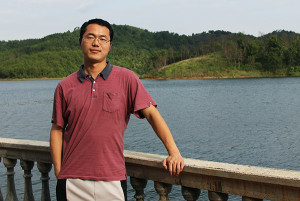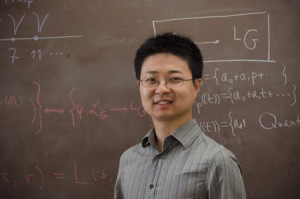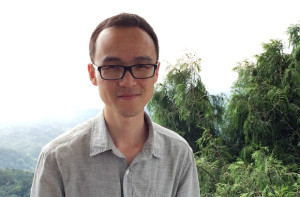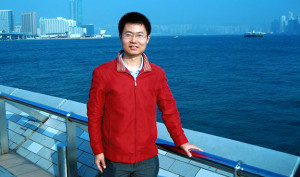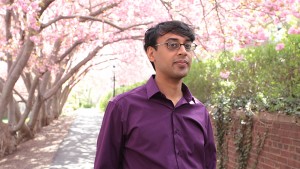One of the first collaborations Xinyi Yuan and Wei Zhang ever undertook was a trip to the Social Security office. It was the fall of 2004 and the two of them were promising young graduate students in mathematics at Columbia University. They were also friends from their college years at Peking University in Beijing. Yuan had come to Columbia a year earlier than Zhang, and now he was helping his friend get a Social Security number. The trip did not go well.
“We went there, and we were told that some document of Wei’s was missing and that he couldn’t do it at that time,” Yuan recalled.
That failed attempt was one of the few unsuccessful team efforts the two have undertaken since coming to the U.S. Zhang, who is now a professor at Columbia, and Yuan, now an assistant professor at the University of California, Berkeley, are members of an unofficial quartet of Chinese mathematicians who have been friends since their undergraduate days at Peking University in the early 2000s and now hold positions in some of the best mathematics departments in the world.
That a number of elite mathematicians would come out of the same class at a top university is unusual, but not unprecedented. The most recent example is Manjul Bhargava, Kiran Kedlaya and Lenny Ng, freshman classmates at Harvard University who went on to become distinguished mathematicians. They remain good friends and all traveled to Seoul in 2014 when Bhargava won the Fields Medal.
What’s unusual about the group formed by Zhang, Yuan and their two friends is the degree to which they continue to collaborate and the extraordinary amount of successes that they’ve had.
“They are not only good, they work in almost the same areas, and because they learned together, they influenced each other, and even as mature mathematicians they’re collaborative,” said Shou-Wu Zhang, a mathematician at Princeton University who knows all four and was influential in recruiting Zhang and Yuan to study in the U.S.
In addition to Zhang and Yuan, the other members of the group are Zhiwei Yun, an associate professor at Stanford University, and Xinwen Zhu, an associate professor at the California Institute of Technology. Yun and Zhu work in the field of algebraic geometry, while Zhang and Yuan work in number theory. This split in fields provides them with complementary perspectives on what is probably the single biggest project in mathematics, the Langlands program, which has been described by the Berkeley mathematician Edward Frenkel (who was Zhu’s graduate adviser) as “a kind of grand unified theory of mathematics.” The program, first envisioned by the mathematicianRobert Langlands in the late 1960s, seeks to draw connections between number theory and geometry, so as to use tools from one field to make discoveries in the other.
One obstacle to pursuing the Langlands program is that it’s difficult for a single mathematician to know both fields deeply enough to see all the connections between the two. Yet mathematicians from different fields may have trouble communicating with one another. The best collaborations involve mathematicians who have deep knowledge of different fields, but who also know just enough in common to talk to each other.
That is the case with these four mathematicians. They are all individually talented, and each has pursued his own research interests over the years. But they are also close friends with a shared background and a similar approach to mathematics. This has allowed them to prompt each other, teach each other, and make discoveries together that they might not otherwise have made so easily. These include several smaller papers they’ve written in tandem and now, most recently, their biggest collaborative discovery yet — a forthcoming result by Zhang and Yun that’s already being hailed as one of the most exciting breakthroughs in an important area of number theory in the last 30 years.
The Early Years
Before their mathematical abilities drew them together, the four grew up in different parts of China. Zhu is from Chengdu, a provincial capital in the southwest. Yun grew up in a town outside Shanghai called Changzhou. At first he was more interested in calligraphy than math. Then, when he was in third grade, a teacher, recognizing Yun’s potential, explained to him that the repeating decimal 0.9999… is exactly equal to one. Yun puzzled over this unexpected fact for months. After that, he was hooked.
Yuan started out in the least auspicious circumstances of the four. He was born in a village close to Wuhan, a poor area with few resources for cultivating mathematical genius. But his teachers quickly noticed his talent.
“My math teachers liked me very much in first and second grade, and I could tell they were surprised by my ability,” he said. “Mainly that I got very high scores, usually perfect scores on exams.” Later, he enrolled in the prestigious Huanggang High School.
In China, as in other countries, there are structures in place that make it likely that top mathematical talents will eventually meet. Zhu and Zhang, who grew up 300 miles away from Chengdu, first met at a summer math camp after 10th grade. Yun and Yuan were both members of the Chinese national Math Olympiad team, a status that reflected their particular technical skill and prowess at solving problems.
In August 2000, the four were among 200 students in the entering class at Peking University. Many of their classmates were good at math, but most aspired to careers in practical fields like finance or computer science. By their junior year, their class had divided up according to interests, and Yuan, Zhang, Yun and Zhu found themselves placed together in a small group focused on pure math.
At that point the four became friends in the typical college way. They’d watch movies, go hiking, and play soccer and basketball together. Yuan, whom they all describe as the most athletic of the group, usually won. During this period, in class and in discussions they organized among themselves, the four also encountered for the first time some of the mathematical concepts, such as automorphic forms, that would later form the focus of their careers. And as they made their way into the world of higher mathematics, they realized they were all fascinated by the same kind of mathematical research.
“By the end of college it was pretty clear to me that the four of us shared a similar taste in mathematics,” Yun said. “That taste is structure-based mathematics. Instead of doing computation, all of us are interested in the big picture and finding interesting examples demonstrating general principles.”
Yuan was the first of the group to take this perspective to the United States. In 2003 he went to Columbia to work with Shou-Wu Zhang. He was drawn abroad by the feeling that in China, he wouldn’t be able to realize his potential as a mathematician.
“I somehow thought that the professors [with whom I interacted] at Peking University were not good enough, were not top mathematicians,” he said. “I wanted to come to the United States earlier just to see these great mathematicians.”
Yuan’s experience as a graduate student surpassed his expectations. It wasn’t just that he suddenly found himself attending conferences and colloquia with the brightest mathematicians in the world. It was also that as he observed these mathematicians up close, he gained a new appreciation for the immense potential in the discipline he’d chosen to pursue.
“In China, mathematicians were not that happy, like somehow they didn’t seem to enjoy math. They gave off the impression that math was hard and you needed to be cautious to choose math as your lifetime career,” he said. “Columbia was totally different. One important thing I saw there was happiness in math, motivation, optimism. These are the parts I didn’t see in China.”
A year later, Yuan’s friends followed him to graduate school in the United States: Zhu went to Berkeley, Yun to Princeton, and Zhang to Columbia. Zhang remembers that soon after arriving in the United States, he realized he’d miscalculated when he would receive his first stipend check and was going to run out of cash. Yuan, who’d had a year to figure out the intricacies of direct deposit, gave him some money to get by.
Even more crucially, Yuan helped Zhang get his bearings in the math department at Columbia. “He gave me more direct access in understanding what professors here studied,” Zhang said. Zhang was particularly attracted to Shou-Wu Zhang’s research. Shou-Wu Zhang, who later left Columbia for Princeton, worked simultaneously in number theory and arithmetic algebraic geometry. Wei Zhang was impressed by what he describes as Shou-Wu Zhang’s ability to “expose ideas directly without hiding them behind a lot of technical ideas.”
Eventually Wei Zhang decided to focus his dissertation research on L-functions, a central topic in modern number theory and one of the most interesting. In particular, he was interested in generalizing the Gross-Zagier formula, which applies to a certain subset of L-functions, to a much broader range of L-functions. This work, which presaged his most recent discovery with Yun, was closely related to Shou-Wu Zhang’s own research, but not confined by it. The freedom to chart one’s own mathematical path, even as a graduate student, is something Wei Zhang likely would not have found had he stayed in China.
“In the Chinese way, you 100 percent follow your teacher and do the problem that’s left from the teacher’s research area,” Shou-Wu Zhang said. “The American way is, you take teacher’s advice with some modification.”
At the same time that Wei Zhang was exploring L-functions, Yuan was finding his own way in number theory, and Yun and Zhu were establishing their research programs in algebraic geometry. During and after graduate school, the four stayed in regular contact. Their paths often crossed in the country’s math centers — in Cambridge, where Yun was a postdoctoral fellow at the Massachusetts Institute of Technology and Zhu was at Harvard, and at Princeton, where Yuan and Yun overlapped during the 2008-2009 academic year.
During that year at Princeton, Yuan and Yun met regularly and began to develop their collaborative style. In informal conversations, Yuan explained the intricacies of number theory to his geometer friend. They spoke in Mandarin and conversed easily; Yuan had a good understanding of what Yun knew and didn’t know, and Yun was able to ask questions, even simple ones, without fear of looking naive. “Because he was able to explain many things to me,” Yun said, “I didn’t find it very difficult, while before I found number theory too difficult for me.”
These conversations, along with the work of the 2010 Fields medalist Ngô Bo Châu, helped Yun understand that many of the techniques he knew from algebraic geometry could be used to attack problems in number theory. This was the goal of the Langlands program, and it had been made apparent to Yun in a very direct way. Now all he needed was a question to address.
The Breakthrough
In December 2014, Zhang flew from New York to the West Coast, where he saw Yun and Yuan. The reason for the trip was a 60th-birthday conference at the Mathematical Sciences Research Institute in Berkeley for the Columbia mathematician Michael Harris, but Zhang also arrived with an idea he wanted to share with his friends. That idea had grown out of a conversation he’d had with Yun back in 2011. At that time, Yun had been thinking about work Zhang had done even earlier on a problem in the Langlands program known as the arithmetic fundamental lemma. Yun thought that some of those ideas could be combined with techniques from algebraic geometry, but he told Zhang he wasn’t sure if it was possible.
“I had some geometric idea which could be true, but I couldn’t make it precise because I was lacking some vision in number theory,” Yun said. “I told Wei, Do you think this thing could be true? He wasn’t sure.”
They left the conversation there for several years. Then in 2014, Zhang realized that Yun’s intuition was correct, and he began to see what it would take to prove it. The problem at hand involved L-functions, which Zhang had studied in graduate school. L-functions have what’s known as a Taylor expansion, in which they can be expressed as a sum of increasing powers. In 1986 Benedict Gross and Don Zagier were able to calculate the first term in the series.
Related Articles:
The Musical, Magical Number Theorist
The search for artistic truth and beauty has led Manjul Bhargava to some of the most profound recent discoveries in number theory.A Tenacious Explorer of Abstract Surfaces
Maryam Mirzakhani’s monumental work draws deep connections between topology, geometry and dynamical systems.
Although L-functions were initially purely objects of number theory, they can also have a geometric interpretation, and powerful techniques from algebraic geometry can be used to study them. Yun had guessed that every term in the Taylor expansion should have a geometric interpretation; Zhang was able to precisely define what such an interpretation would look like. Whereas Gross and Zagier (and the French mathematician Jean-Loup Waldspurger) had been able to obtain exact formulas for the first and second term in the expansion, the new work would show how to obtain a geometric formula for every term.
Zhang explained his thinking to Yun and Yuan at Yuan’s house. As he listened, Yun remembers thinking that Zhang’s ideas fit together so well, they had to be true.
“He had the vision for this sort of global picture that made what I had vaguely in my mind very precise,” Yun said. “I think I was really kind of astonished when he laid out the whole thing. It was so beautiful.”
After that night, it took Zhang and Yun about nine months to prove their ideas. By September of this year, they had an early draft of a paper and began to give informal talks on their efforts. By the end of November, they had a completed draft. Shou-Wu Zhang, who has seen the work, estimates they completed the work at least a year faster than Wei Zhang could have managed on his own — assuming, that is, that the approach would have even occurred to him.
The result still has to go through peer review, but it is already generating excitement in the math world. Among other implications, it opens a whole new window onto the famed Birch and Swinnerton-Dyer conjecture, which is one of the seven Millennium Prize Problems that carry a million award for whoever solves them first.
But the effects of Zhang and Yun’s latest work go beyond math. Zhang and Yun met as teenagers, grew up with Zhu and Yuan across two continents, and came of age together as mathematicians. Now the benefits of the friendship are spilling over into the rest of the mathematical world.
“These four people have different styles and methodologies to attack problems, so combined together, it’s simply great,” says Shou-Wu Zhang.
Editor’s note: Benedict Gross is a member of Quanta Magazine’s advisory board.
Update on December 10, 2015: This article has been updated to include links to the new work.
 1 New Concepts in Science*
1 New Concepts in Science*
![[No Caption]](https://www.quantamagazine.org/wp-content/uploads/2015/12/4Theorists_1200.jpg)
